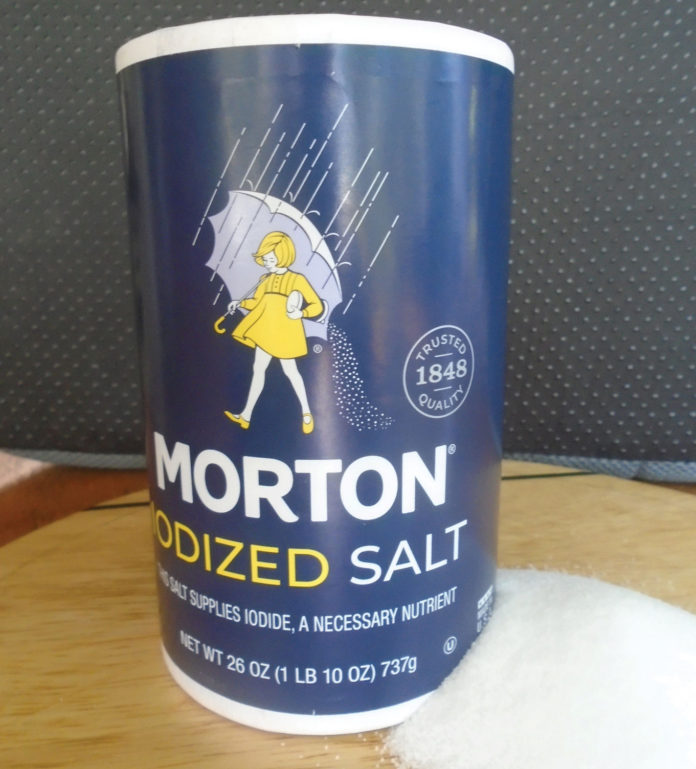“Ye are the salt of the earth.” —Jesus of Nazareth
At the age of 5 years old, I would eat my bowl of oatmeal or cream of wheat while looking at the little Morton’s “salt girl” who carried her umbrella and her blue container of salt while the salt was spilling from its carton onto the ground behind her.
“Even in rainy weather the salt flows freely,” read the ad. And so it does, even today.
Aunt would always add a pinch of salt to the water before adding in the oats to brighten the flavor, and always added salt to any water where vegetables were to be cooked. Salt…the most important condiment to me.
As early as 6500BC, salt was prized and used as money and wars have been fought over salt. Too much salt has ruined many a dish of food, and lack of salt has created health issues within our bodies.
Today in our supermarkets you see more types of salt than you can count, and prices go from $.40 to $.80 per pound and on the extreme end is Himalayan Pink salt from $5 to $30 per pound.
Culinary schools use kosher salt in their kitchens as do I in my cooking. For my guests I fill my shakers with Morton’s table salt and my grinder I fill with kosher salt crystals.
While standing at the stove, you get a much better idea of how much salt you are putting into or on your food if you add the salt with your fingers, and kosher salt is easier to apply that way. I keep a pot of kosher salt handy by the side of my stove.
I was taught to apply an even layer of salt to the pot by picking up a pinch of kosher salt, then hold my hand high above the pot before sprinkling it.
Because of turbulence in the air, your salt will rain down upon your food in a pattern that shows a normal bell curve distribution from where you drop it. The higher you drop the salt from, the more even the distribution. You’ve witnessed the chefs on TV cooking shows using this method of salting foods.
If you use table salt in your cooking, you should use two-thirds of what is called for as table salt, being very fine, packs tighter in your measuring spoon.
Always, and I do mean always, use less than the recipe calls for on your first round of salting. Taste the food, then add the rest of the salt called for.
My method is to taste the food after each additional ingredient is added as canned foods such as tomatoes, broths, etc., have salt included and I find it easy to oversalt. Remember, salt once added cannot be removed.
I never waste my money on what I call “designer salts.” Whether they are gray, pink or even black, they carry no difference in taste. Their only value, as far as I am concerned, is that they might look “pretty” on your food or add additional crunch to your tomatoes.
There are, however, very serious health problems with the overuse of salt in our diets of today. Peanuts, popcorn, potato chips and even salted chocolate candies and desserts with salt flakes added on top, are contributing to serious health issues.
One-fourth of a “level” teaspoon of table salt should NOT BE EXCEEDED in anyone’s daily diet today. This is a hard and true fact. And if you are prone to kidney disease, high blood pressure or cardio-vascular disease, salt can be deadly.
So, what do we do if we crave salt and food doesn’t taste right without salt? Many of us turn to low-salt products or salt substitutes.
You should be aware that salt substitutes can be dangerous to your health. Once again, it’s all in the chemicals. Salt substitutes typically swap sodium chloride for potassium chloride. NOT A GOOD SWAP.
Salt substitutes can be a healthy alternative for some people because potassium is an important mineral that helps lower blood pressure. However, this substitute can be dangerous when you have conditions such as kidney disease, heart disease, high blood pressure, liver disease or diabetes.
Using salt substitutes can be exceedingly dangerous if you are on certain medications, especially diuretics.
Bottom line…do NOT take salt substitutes unless they’re approved by your physician. Remember, a little salt goes a long way.
The recipe below is a great salsa to use on any grilled meat, poultry or fish and can be added atop appetizers, especially grilled baguettes. The hearty spices in the recipe help to replace the flavor of salt.
No Salt Salsa
4 Roma tomatoes diced
1/2 red onion, diced
3 cloves of garlic, minced
1 Jalapeño pepper, deveined and seeds removed before dicing.
1/4 tsp. cumin
1/4 tsp. oregano
1 tsp. lime zest
2 tsp. lime juice
Mix well and refrigerate.
Colly Gruczelak, a Ben Lomond resident, loves people and loves to cook. Contact her at cz****@*****st.net.













